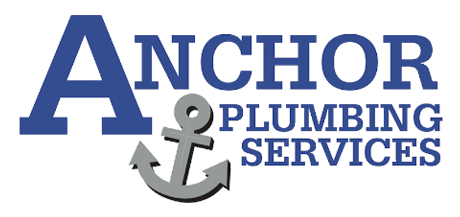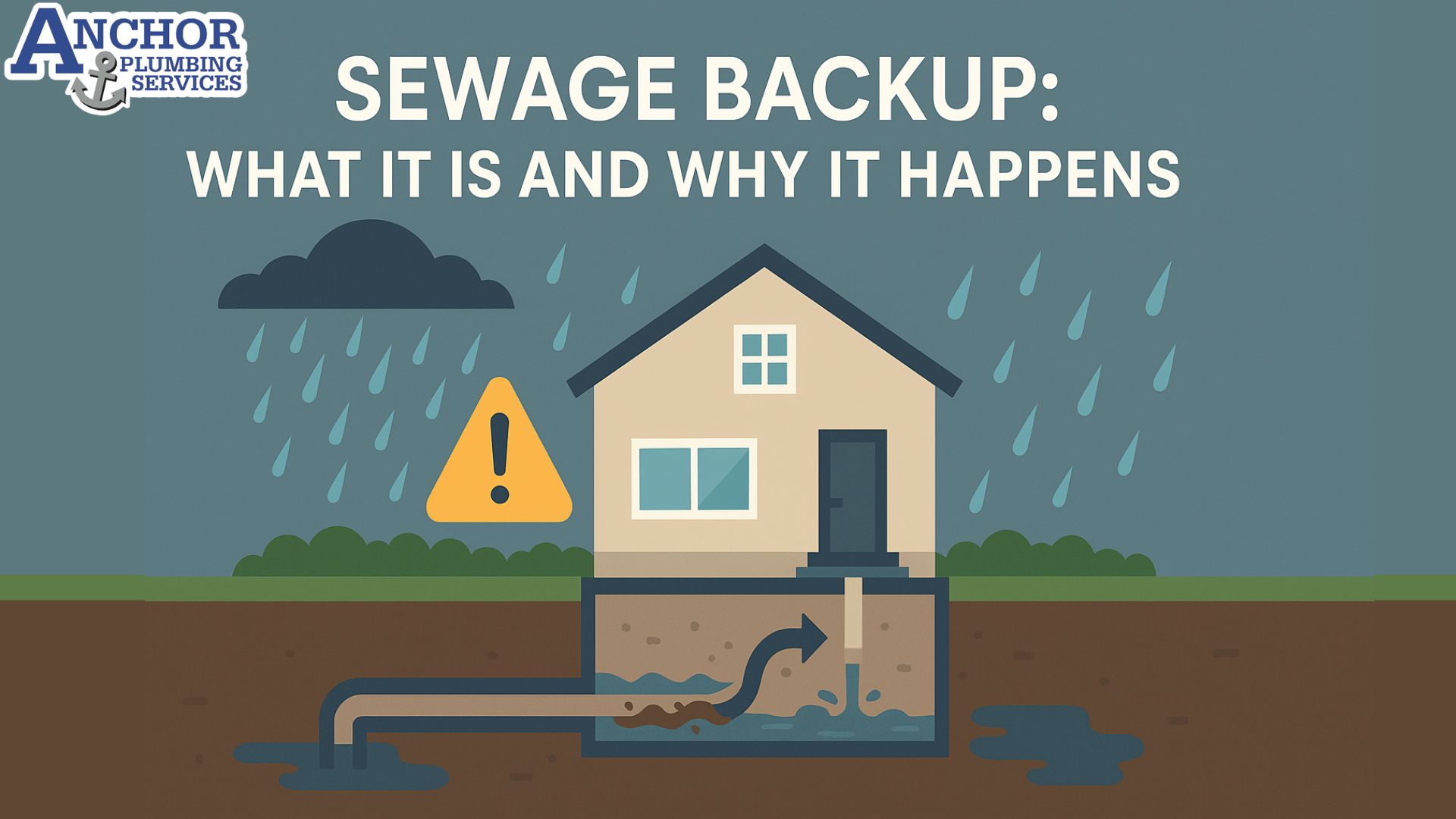Sewage backups are a growing concern in many U.S. homes, especially in areas with aging infrastructure or frequent storms. These events occur when wastewater from toilets, sinks, or floor drains reverses direction and enters your home. The results can include costly damage to floors, walls, and belongings and can pose serious health risks due to bacterial contamination.
According to the EPA, sanitary sewer overflows (SSOs) are a major public health threat in cities with outdated or overburdened sewer systems. Many incidents occur during heavy rainfall, when municipal sewers become overwhelmed and force wastewater back into private plumbing systems.
This guide provides homeowners with a complete breakdown of what causes sewage backups, how to spot early warning signs, how to clean up safely, and how to prevent future problems. Whether you’re dealing with basement flooding or need a sewer line repair, understanding the root causes is key to protecting your property and health.
What is a sewage back up and why does it happen?
A sewage backup occurs when wastewater fails to flow properly through your home’s plumbing system and instead reverses into sinks, toilets, or drains. This reversal often brings in contaminated water, known as blackwater, which contains human waste and pathogens.
There are two common types of backups:
- Isolated fixture backups: Affect a single drain or toilet, typically caused by a localized clog.
- Main line backups: Affect multiple drains and are usually linked to a blockage or failure in the main sewer line or municipal sewer connection.
Common causes of residential sewage backups include:
- Tree root intrusion into underground sewer lines
- Grease buildup from cooking fats hardened in pipes
- Structural pipe failure due to corrosion or collapse
- Heavy rainfall or stormwater overwhelming the local sewer system
- Improperly disposed items like wipes or hygiene products
When the wastewater removal system fails — whether due to blocked pipes or overwhelmed city infrastructure — sewage has nowhere to go and flows back toward the lowest open fixture inside the home.
For example, during a heavy storm, a home without a backwater valve may experience sewage entering the basement floor drain due to pressure from the municipal sewer.
How do you know if your sewer is backed up?
A sewer backup often starts with plumbing issues like gurgling toilets, slow drains, or sewage odors. These signs suggest a blockage in the main sewer line, not just a clogged fixture. If water backs into a floor drain or appears near the sewer cleanout, the problem may involve the municipal sewer system or a failing line.
Common signs your sewer may be backing up:
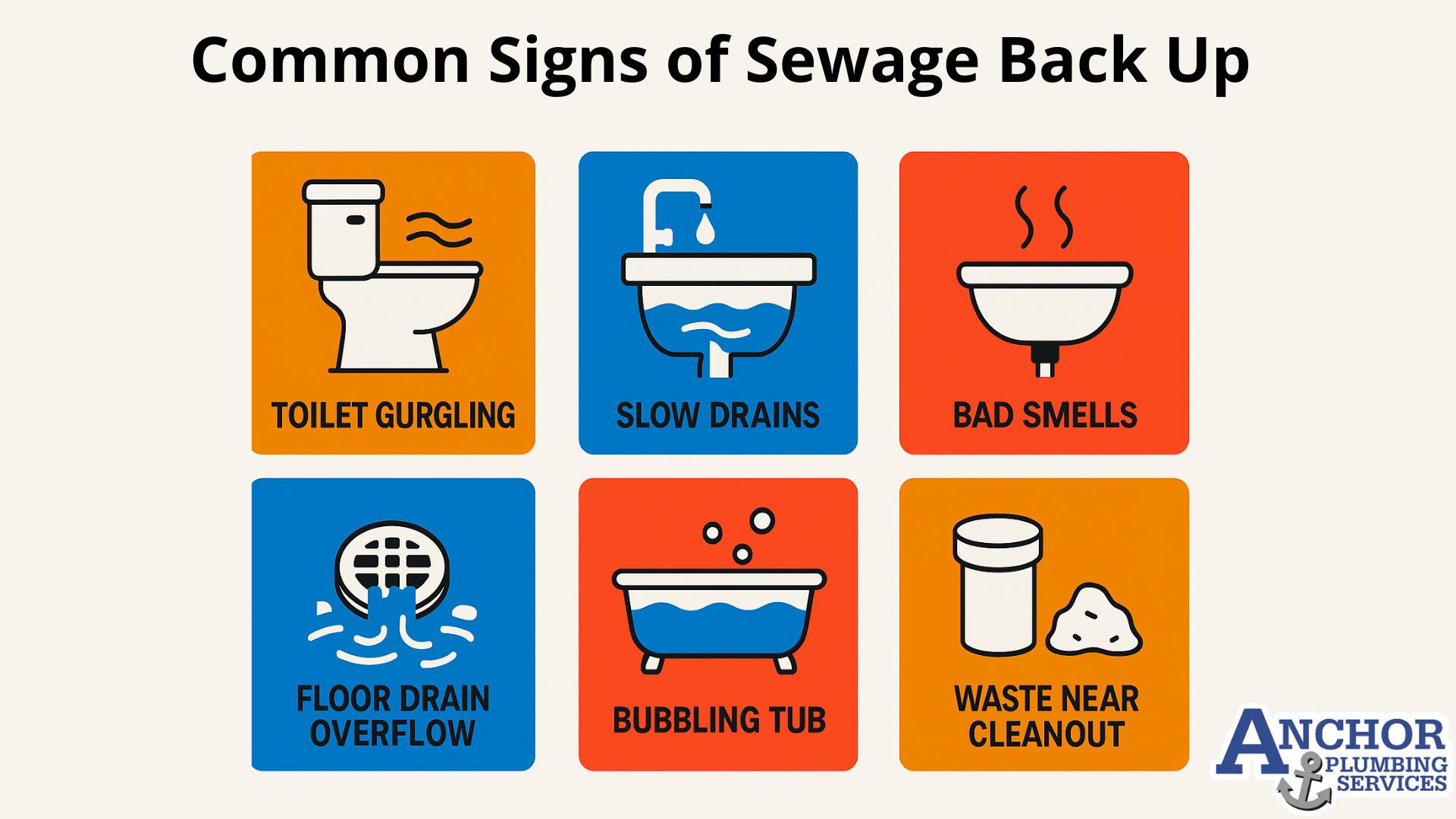
- Gurgling toilets: Gurgling or bubbling sounds in the toilet bowl after flushing indicate air displacement caused by a blockage in the main sewer line or vent stack.
- Slow-draining sinks and tubs: When multiple sinks, tubs, or showers drain slowly at the same time, it often signals a main line obstruction preventing normal wastewater flow.
- Foul odors from drains: A sulfur-like or sewage smell near sink drains or showers suggests methane gas is entering the home due to sewer pressure buildup or stagnant waste.
- Water backing into basement drains: Basement or utility room floor drains overflowing with dirty water is a clear sign that sewage cannot exit properly and is reversing into the home.
- Water bubbling in toilets or bathtubs: When you flush one fixture and water bubbles or rises in another, it indicates pressure buildup or backflow in a shared drainage path.
- Wastewater seeping near the sewer cleanout: If you notice water or solid waste pooling near your sewer cleanout cap, the main sewer pipe may be partially or fully blocked downstream.
How to clean sewage backup safely?
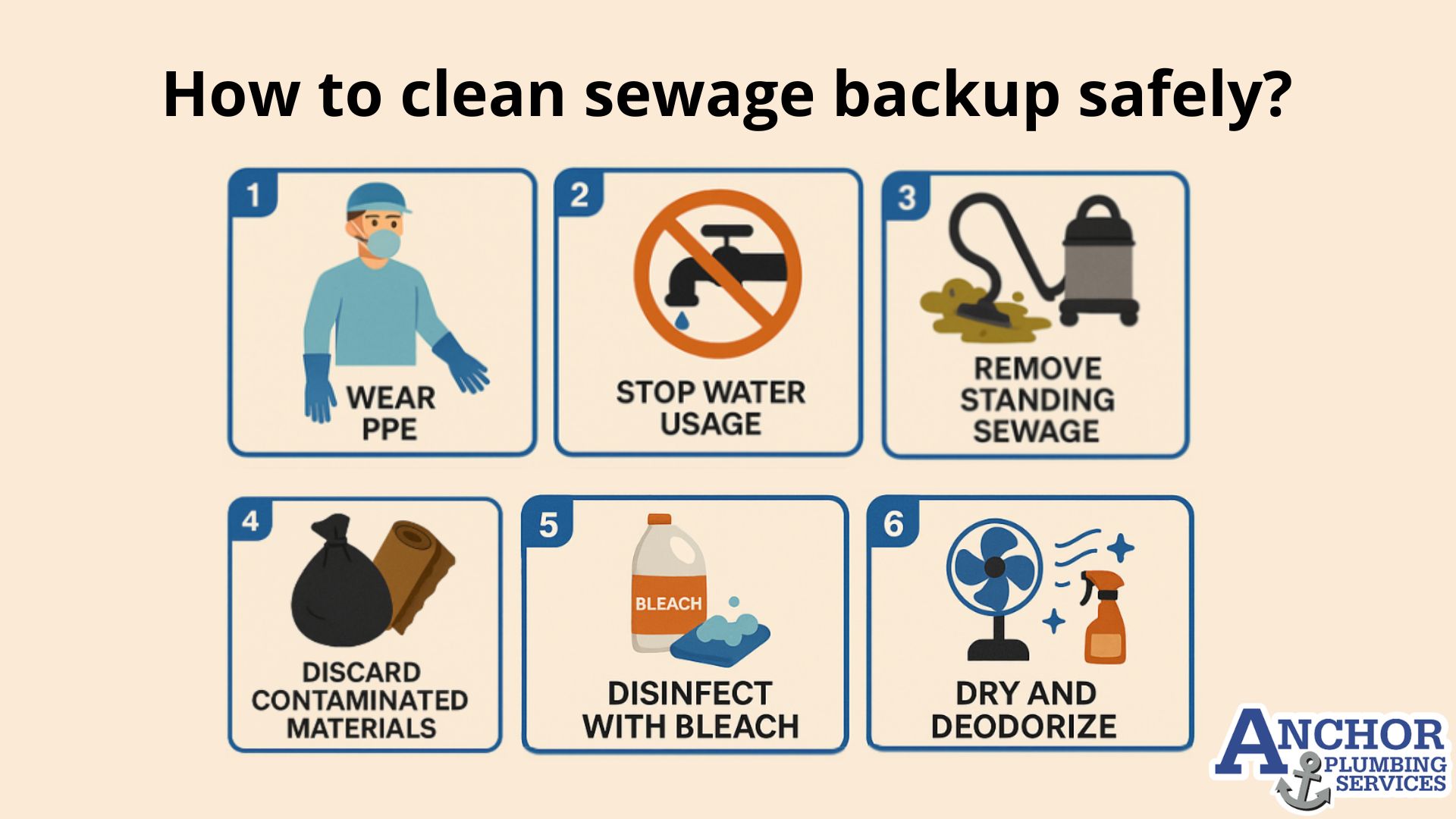
Cleaning a sewage backup requires strict safety precautions to avoid exposure to harmful bacteria, viruses, and blackwater contamination. Minor spills can be addressed with proper protection, but larger backups require professional remediation.
Step-by-step sewage cleanup protocol:
- Wear proper protective equipment (PPE): Use rubber gloves, waterproof boots, safety goggles, and an N95 or higher-rated mask before entering the area.
- Stop water usage: Shut off the water supply and avoid flushing toilets or running drains to prevent more wastewater from entering the space.
- Remove standing sewage water: Use a wet/dry vacuum or pump to extract water. Never use standard home vacuums. Bag and discard any visible waste.
- Dispose of contaminated materials: Remove and discard porous materials like carpet, drywall, cardboard, and insulation. These items absorb waste and cannot be sanitized.
- Clean and disinfect hard surfaces: Scrub with a bleach solution (1:10 ratio) or EPA-approved disinfectant. Focus on floors, walls, and fixtures. Let surfaces air dry fully.
- Dry the area completely: Use fans and dehumidifiers to remove moisture. Mold growth begins within 24–48 hours if humidity remains high.
- Deodorize if needed: Apply odor-neutralizing sprays or use activated charcoal to absorb lingering smells.
If sewage affects more than 10 square feet, enters drywall or HVAC ducts, or involves multiple rooms, hire a certified plumbers team.
What health risks are associated with sewage back up?
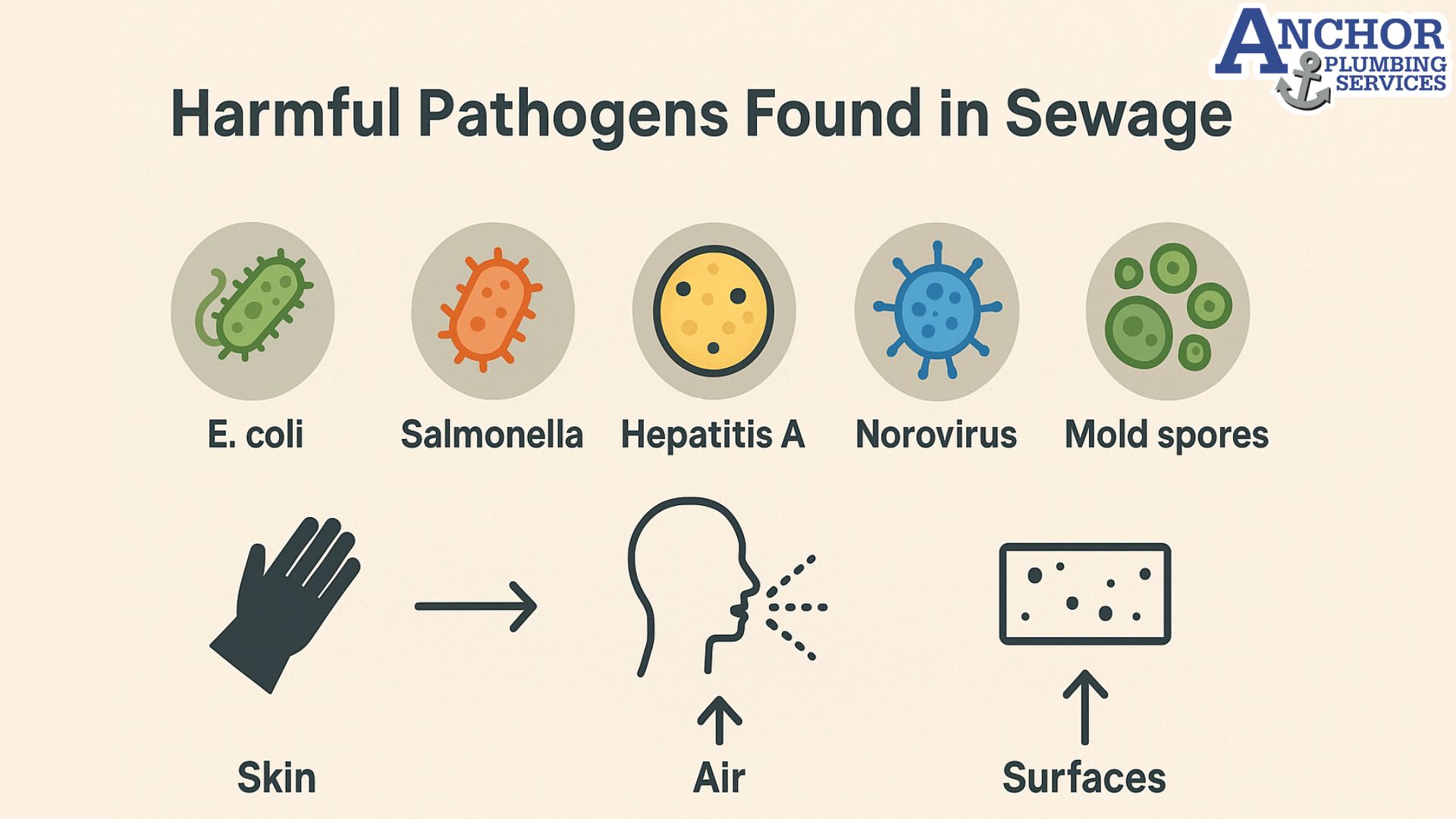
Sewage backup exposes occupants to serious biological hazards. The wastewater often contains bacteria, viruses, parasites, and toxic gases. If not cleaned quickly, it can also promote mold growth, which harms indoor air quality and affects long-term health.
Key pathogens found in sewage:
- E. coli: A common bacteria in human waste. It can cause stomach cramps, vomiting, and diarrhea after exposure.
- Salmonella: Found in fecal matter. Can spread through contact with contaminated surfaces and cause severe gastrointestinal illness.
- Hepatitis A: A liver infection spread through fecal-oral transmission. Exposure risk increases during cleanup without gloves or handwashing.
- Norovirus: Highly contagious virus that spreads easily from surface contact. Can cause nausea, vomiting, and dehydration.
Mold & airborne exposure risks:
If moisture lingers after cleanup, mold can develop on drywall, insulation, or floors within 24–48 hours. Mold spores aggravate asthma, trigger respiratory infections, and pose a risk to those with weakened immune systems.
Backup contamination can also affect HVAC systems by distributing airborne pathogens throughout the home. Air ducts, if exposed, must be inspected and cleaned by professionals.
For additional health information, refer to EPA flooding and indoor air quality guidance.
How to clear a backed up sewer drain?
Clearing a sewer backup begins by identifying if the issue is isolated or system-wide. Minor clogs near a toilet or sink can be cleared with simple tools. Main line backups require access to the sewer cleanout and may involve professional equipment.
Basic methods for minor clogs:
- Plunging: Creates suction to dislodge soft clogs in toilets and shallow drains. Use a flange plunger for toilets and a cup plunger for sinks.
- Drain snake or auger: Pushes through hair, grease, and debris in shower, tub, or sink lines. Manual and powered versions are available.
- Enzyme-based treatments: Useful for grease or organic buildup in slow drains. Not effective on full blockages or solid obstructions.
When to call a professional:
- Sewer cleanout access: This is a capped pipe outside the home that connects directly to the sewer line. If water is pooling here or won’t drain, the main line is blocked.
- Hydro jetting: A high-pressure water technique used by plumbers to clear tree roots, grease, and solid obstructions from main sewer lines.
- Sewer camera inspection: Plumbers use a waterproof video camera to inspect the entire sewer lateral, locate damage, and confirm blockages before jetting or repair.
DIY methods work for surface-level issues. For collapsed pipes, large backups, or no access to the cleanout, call a licensed plumber.
Does San Antonio experience frequent sewage backups?
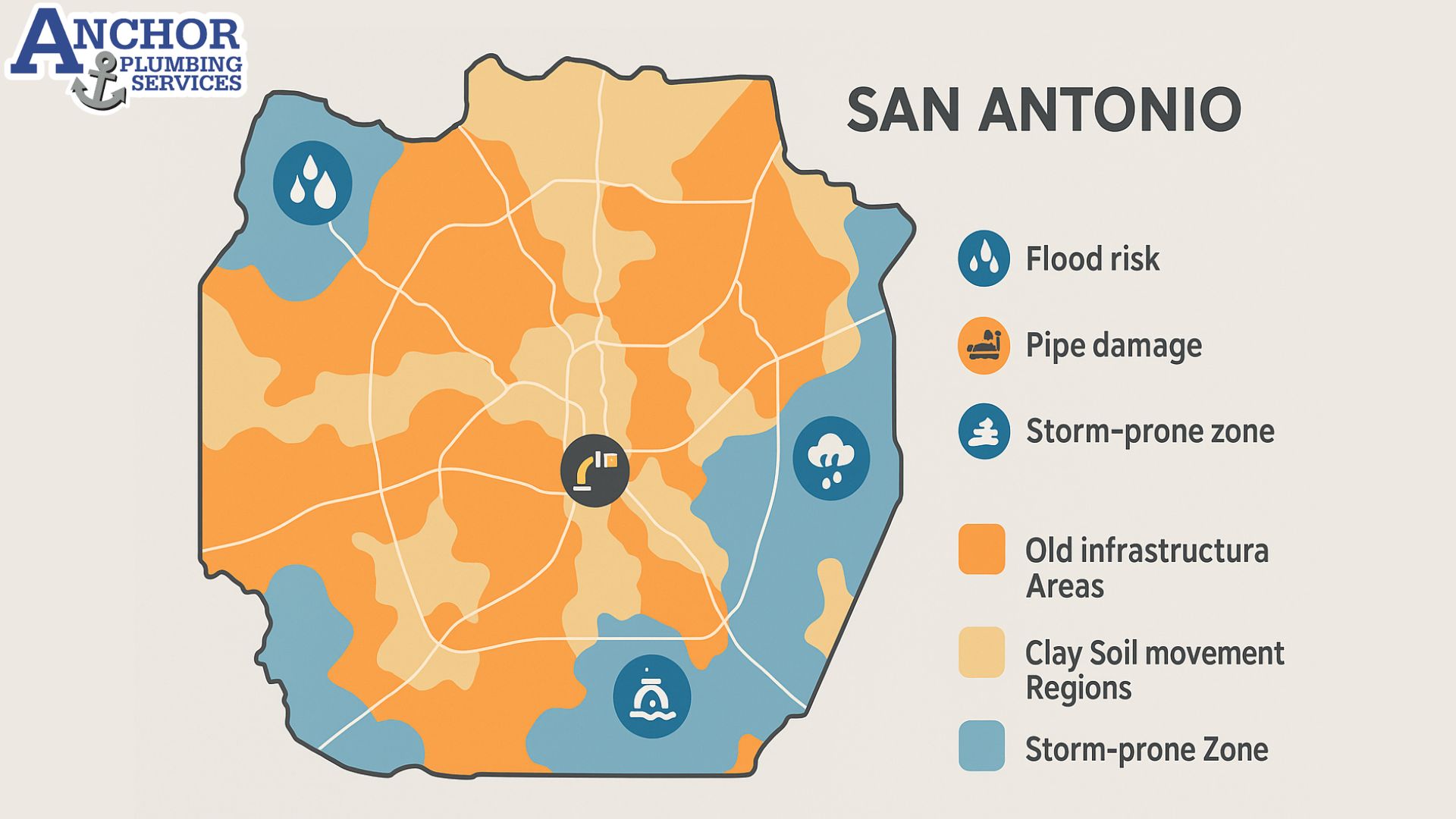
Yes, San Antonio is prone to sewage backups due to aging infrastructure, stormwater stress, and shifting soil conditions. Many older neighborhoods still rely on clay or cast-iron sewer lines, which deteriorate or collapse under pressure.
The city’s expansive clay soil expands when wet and contracts during dry periods. This causes underground pipe displacement, increasing the risk of cracks or misalignments that lead to blockages.
During intense summer rainstorms, the municipal sewer system may reach capacity, pushing wastewater back into private lines. Homes without backwater valves or those located at low elevations are especially vulnerable.
The San Antonio Water System (SAWS) states that homeowners are responsible for clearing blockages within their private sewer laterals. SAWS will inspect the city line if needed, but homeowners must first confirm the issue through a licensed plumber’s camera inspection (source).
Additionally, permits may be required for sewer repairs or backwater valve installation. Compliance with San Antonio plumbing codes ensures safe and approved remediation work.
Frequently Asked Questions
Is sewage backup covered by insurance?
Yes, if your policy includes a sewer or water backup endorsement. It typically adds $50–$150 annually. Standard policies do not cover this damage.
Can you stay in a home with sewage backup?
Not during active contamination. Once the area is cleaned, dried, and disinfected, it is safe to return. Exposure during cleanup is not advised.
What happens if you don’t clean it properly?
Improper cleaning causes mold growth, lingering odors, and bacterial spread. This may lead to respiratory issues or structural damage to floors and walls.
Conclusion
Sewage backups in residential homes are serious plumbing emergencies. They’re commonly caused by blocked sewer lines, aging pipes, or storm-related overflow. Early warning signs like gurgling toilets, slow drains, and foul odors should never be ignored. Cleanup requires strict safety measures, and professional restoration is often needed for extensive damage.
Preventing future backups involves more than just good habits — it includes system upgrades like backwater valves and regular inspections. For homeowners in high-risk areas like San Antonio, understanding these risks and acting early can protect both property and health.
If you’re dealing with frequent sewer backups, note that foul odors or slow drains can signal serious line damage. Anchor Plumbing Services offers expert sewer line repair in San Antonio to diagnose and fix the issue fast.
